Say hello to Beetroot Poriyal – a lightly spiced South Indian special preparation made with beets, coconut, spices and herbs. While you might be consuming beetroot in salads and juices, this is one of those easy ways where you can even cook this super nutritious root vegetable. As obvious, this dry dish has a beautiful red color to it because the beetroot perfectly colors it with its natural hue. The addition of spices and coconut add to the earthiness of this tasty dish.

What is Poriyal
If you are in the South Indian state of Tamil Nadu, you will come across the popular food term ‘poriyal,’ which would generally mean a form of sautéed or fried dish. Similar terms in other languages are ‘mezhukupuratti’ (Malayalam), ‘palya’ (Kannada) and ‘vepudu’ (Telugu).
A type of side dish, it typically has a vegetable (shredded or finely chopped) which is cooked with whole spices, curry leaves and black gram (urad dal). Sometimes onions, dried red chilies and other spice powders may also be added. It is usually finished with heap of coconut and coriander (optionally).
In addition to this Beetroot Poriyal, other variants include Carrot Poriyal, Cabbage Poriyal, Beans Poriyal, Raw Banana Poriyal and Ivy Gourd Poriyal. Though, the list doesn’t end at this.
More on Beetroot Poriyal
I often make this Beetroot Poriyal and other veggie poriyals at home. This dish is a preferred one because it is really simple to make (just like the Kerala thorans) and is healthy too. So, whenever I am making a sambar, a vegetable poriyal or thoran also is an option by default.
This recipe of Beetroot Poriyal is also a no onion, no garlic one. Other basic ingredients that go in this preparation are mustard seeds, green chillies, curry leaves, urad dal, asafoetida and some coconut. Make it gluten-free by not adding the asafoetida.
Whether you want to chop or grate the beetroot, the choice is yours. The poriyal is tasty both ways. Though, using grated beetroot will always lessen the time to cook the vegetable.
I always cook the Beetroot Poriyal in coconut oil as that’s what is the essence of this dish. But you can substitute it with sesame oil (gingelly oil) as well.
You can make the poriyal with other veggies like the ones I have mentioned in the above section. There is no end to that. Each one will be just as fab as the other, this much I can assure you.
At home, I had this Beetroot Poriyal with a yummy sambar and steamed foxtail millet combo. For regular times, this poriyal goes good with a Sambar-rice or Rasam-rice combination. You can have it with chapati too for a wholesome meal.
How to make Beetroot Poriyal
1. In a pan, heat 2 tablespoons coconut oil or sesame oil (gingelly oil). Keep the heat to a low and add 1 teaspoon mustard seeds.

2. Let the mustard seeds crackle.

3. When the mustard seeds begin to crackle, add 1 teaspoon urad dal (split and husked black gram).

4. Stirring often, fry the urad dal on low heat.
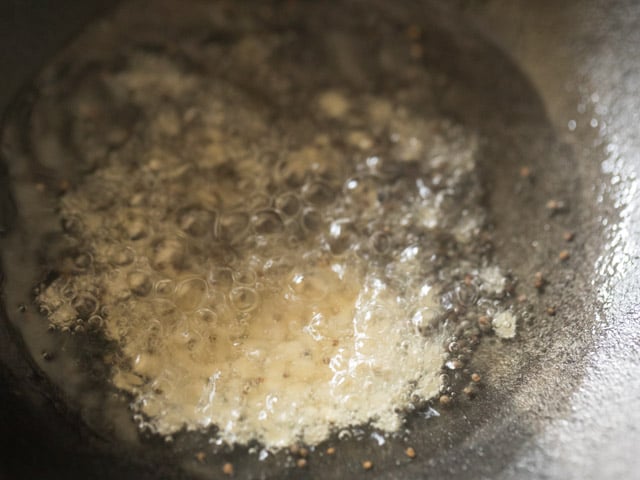
5. Fry till the urad dal turns golden.

6. Then, add 1 chopped green chili (about ½ to 1 teaspoon, chopped), 10 to 12 torn or chopped curry leaves and 1 pinch asafoetida (hing). Mix well.

7. Now, add 2 cups finely chopped beetroot (or 2 medium to large beetroot or 250 grams finely chopped beetroot). You can also add grated beetroot.

8. Mix very well.

9. Add salt as per taste and mix again.
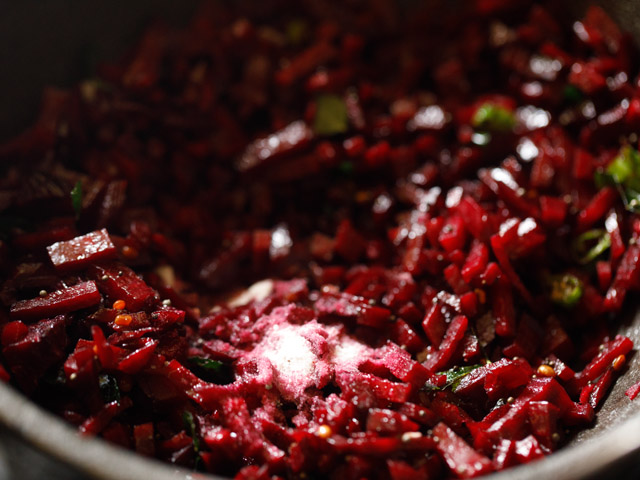
10. Add ⅓ cup water or add as required.

11. Cover the pan with a lid and let the beetroot cook on low to medium-low heat.
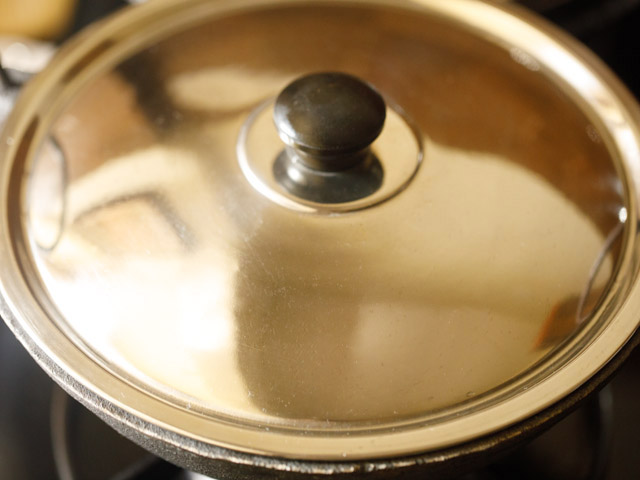
12. Do check and stir, in between. If the water dries up, add some water and then continue to cover and cook.

13. The beetroot should soften and get cooked completely. Before proceeding to the next step, ensure there is no water in the pan.
If the beetroot pieces are softened and there is some water, then cook without the lid, so that all the water evaporates.

14. Lastly, add 3 to 4 tablespoons grated fresh coconut.

15. Mix very well. Switch off the heat and cover the pan.
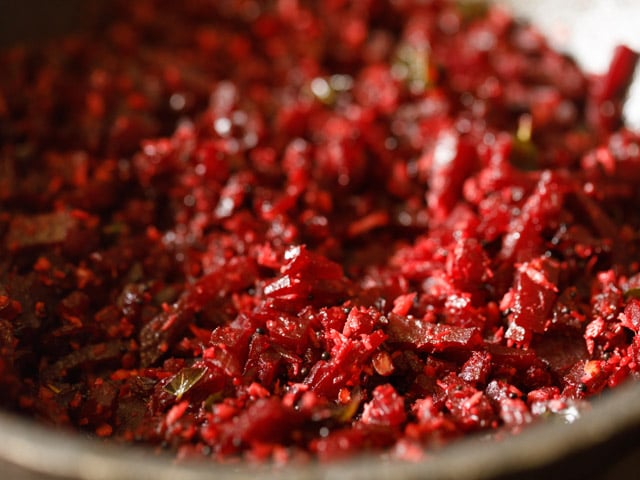
16. Serve the Beetroot Poriyal hot or warm as a side dish with sambar-rice, rasam-rice or even dal-rice. It can also be had with chapatis, plain paratha or bread.
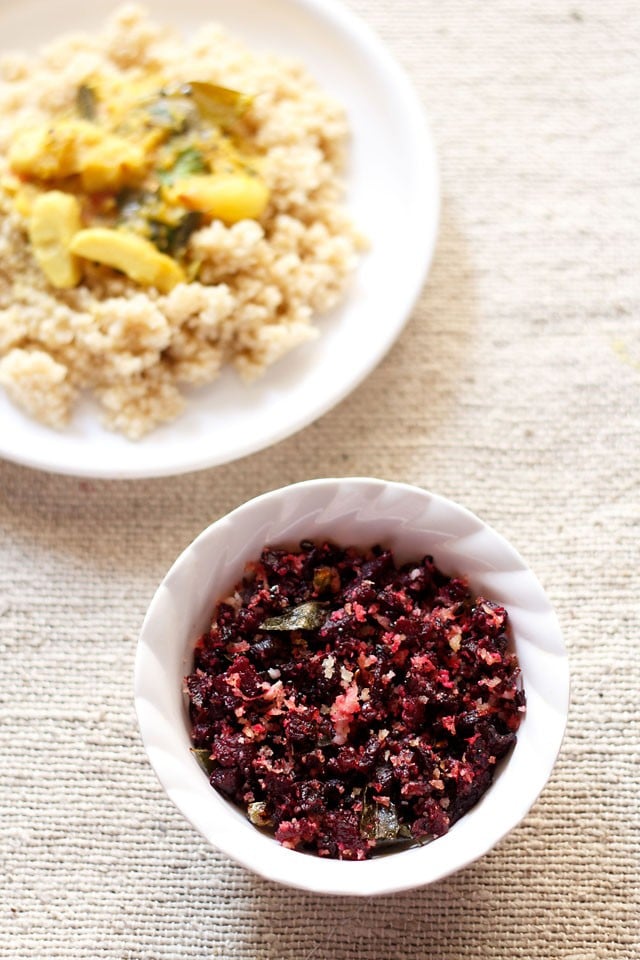
More Beetroot Recipes To Try!
Vegetable Recipes
Chutney Recipes
Snacks Recipes
Breakfast Recipes
Please be sure to rate the recipe in the recipe card or leave a comment below if you have made it. For more vegetarian inspirations, Sign Up for my emails or follow me on Instagram, Youtube, Facebook, Pinterest or Twitter.

Beetroot Poriyal
Ingredients
- 2 tablespoons coconut oil or sesame oil (gingelly oil)
- 2 cups beetroot (finely chopped or grated) or 2 medium to large beetroot or 250 grams
- ½ to 1 teaspoon chopped green chillies or 1 green chilli
- 10 to 12 curry leaves – chopped or kept whole
- 1 teaspoon black mustard seeds
- 1 teaspoon urad dal (split and husked black gram)
- 1 pinch asafoetida (hing)
- salt as required
- ⅓ cup water or add as required
- 3 to 4 tablespoons coconut – fresh and grated
Instructions
- In a pan heat the coconut oil or gingelly oil (til ka tel or sesame oil made from raw sesame seeds). Keep heat to a low and add mustard seeds.
- When the mustard seeds begin to crackle, add urad dal. Stirring often fry the urad dal till they get golden and aromatic.
- Then add chopped green chillies, curry leaves (chopped or whole) and asafoetida. Mix well.
- Then add finely chopped or grated beetroot.
- Mix very well.
- Add salt as per taste and mix again.
- Add ⅓ cup of water or add as required.
- Cover the pan with a lid and let the beetroot cook on a low to medium-low heat.
- In between do check and stir. If the water dries up, then you can add some water and then continue to cover and cook.
- The beetroot should soften, become tender and get cooked completely. Before proceeding to the next step ensure there is no water in the pan. If the beetroot pieces have softened and there is some water, then cook without lid, so that all the water evaporates.
- Lastly add 3 to 4 tablespoons grated fresh coconut. Mix very well. Switch off the heat and cover pan.
- Serve the Beetroot Poriyal hot or warm as a side dish with sambar-rice or rasam-rice or even dal-rice. It can also be had with chapati or paratha.
Notes
- Use fresh, tender and juicy beets.
- You could skip coconut if you do not have it or add desiccated coconut instead. Note that with desiccated coconut the taste will change slightly.
- The recipe can be doubled or tripled.
- This approximate nutrition info is per serving (made with coconut oil).
Nutrition Info (Approximate Values)
This Beetroot Poriyal recipe from the archives first published on July 2013 has been republished and updated on November 2022.
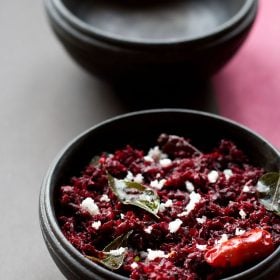

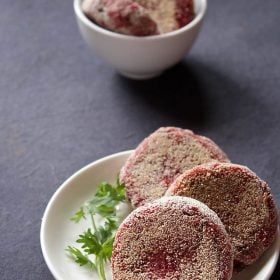









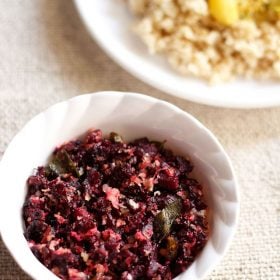
thank you it was a good and clear recipe with illustrative pics.
thank you and welcome.
Hi Dassana
I love your recipes. Almost all of them are easy to follow and also include easily available ingredients – I’m a non-cook and have tried a few of your recipes like thepla, aloo, etc and love them. Even this one is so simple. I will definetly try it out.
Thanks for putting up all your lovely recipes. And I’m greedy so I will say keep adding to your list 🙂 !!
thank you mansi. glad to read your comment. do try beetroot poriyal and you will like it. yes, i will be adding more recipes.
welcome and happy cooking.
Tried this recipe using boiled beet roots and it turned out simply delicious.
thanks again winnie. boiled vegetables can also be used to make various poriyals. to save time and an extra pans going for washing, i simply cook the vegetables in one pan.
Hello Mam, I have been following your recipes lately and I must say that you simplify the recipes to such an extent that even a lazy person likes me gets into cooking..and WRT this recipe: What if coconut is not added? Will that affect the dish? Thanking u in advance. 🙂 and keep posting more yummy recipes..xo
thanks indrani. not adding coconut will affect the taste. however, still you can make without coconut, if there is no grated coconut available.